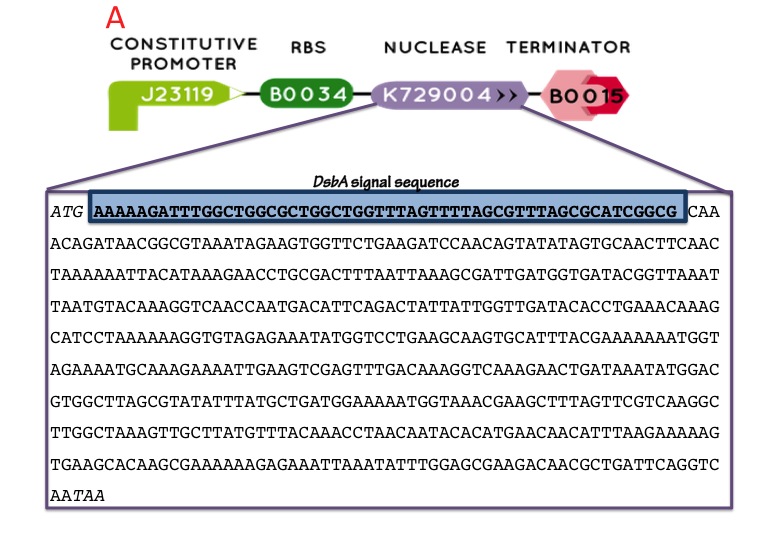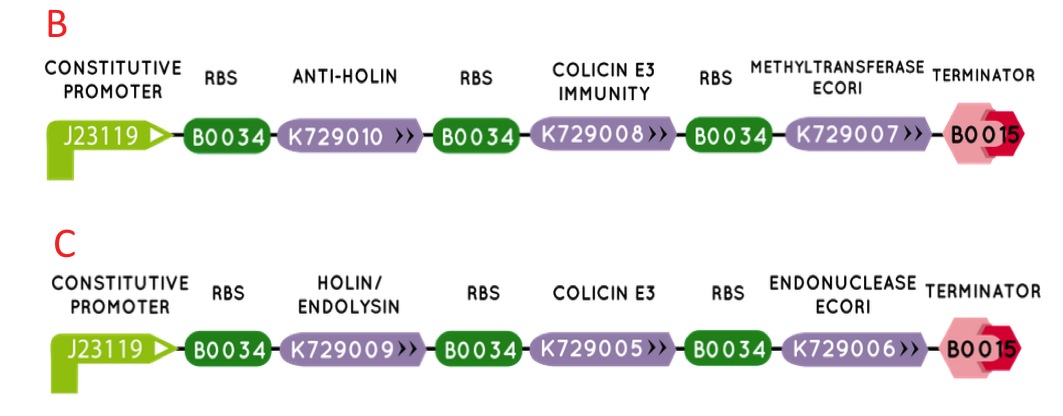Team:University College London/Module 6/Design
From 2012.igem.org
Sednanalien (Talk | contribs) (→Design) |
(→Design) |
||
| (22 intermediate revisions not shown) | |||
| Line 7: | Line 7: | ||
| - | + | [[File:A123.jpg|center|700px]] | |
| + | [[File:UniversityCollegeLondon_Containment_Toxin_Anti-toxin.jpg|center|900px]] | ||
| - | We have identified | + | We have identified two key requirements for the design of the Containment Module. |
| - | '''Requirement: The system must be able to effectively counter horizontal gene transfer, preventing our cells from being able to transfer their genes into wild strains of cells.''' | + | |
| + | '''Requirement 1: The system must be able to effectively counter horizontal gene transfer, preventing our cells from being able to transfer their genes into wild strains of cells.''' | ||
Horizontal gene transfer can occur in several ways: | Horizontal gene transfer can occur in several ways: | ||
| Line 23: | Line 25: | ||
| + | '''Requirement 2: ''Staphylococcus aureus'' nuclease B is designed to have a signal peptide (''dsbA'') that works as a secretion enhancer when nuclease is expressed in ''E. coli'' so it does not degrade ''E. coli'' DNA. The designed sequence was synthesized by the gene synthesis company Eurogentec.''' | ||
| - | In our examination of the literature, we have identified several systems that could be utilised to prevent horizontal gene transfer. A multi-containment system, comprising Holin, Colicin E3, and EcoRI restriction endonuclease has been identified to be ideal for our purposes. From the literature | + | In our examination of the literature, we have identified several systems that could be utilised to prevent horizontal gene transfer. A multi-containment system, comprising Holin, Colicin E3, and EcoRI restriction endonuclease has been identified to be ideal for our purposes. From the <span class="footnote" title="DualContainment">literature</span>, it has been determined that multi-containment systems are more effective than mono-containment systems, and as such, we have decided to do the same. Furthermore, as the expression of suicide genes may be variable in different microbial strains, multi-containment systems would significantly reduce the effects of horizontal gene transfer. |
| + | As the multi-containment system is an effective guard against bacterial conjugation, but not necessary against transformation, we have decided to incorporate a periplasmic nuclease into our containment system as well. Any DNA released due to cell lysis would be degraded by the nuclease. | ||
| - | + | Due to the constrains of our project, we are unable to implement a system that would directly target transduction. As transduction has been suggested to be a key mechanism for horizontal gene transfer in the <span class="footnote" title="Transduction">marine environment</span>, this would be an area that we would wish to investigate further in the future. | |
| - | + | ||
| - | + | ||
| - | Due to the constrains of our project, we are unable to implement a system that would directly target transduction. As transduction has been suggested to be a key mechanism for horizontal gene transfer in the marine environment | + | |
| - | + | ||
While the traditional concept of containment involves preventing biologicals from escaping into the environment, the advent of synthetic biology has causes a paradigm shift in this concept. As many synthetic biology projects target the environment, requiring the deliberate release of synthetic organisms into the biosphere, the concept of containment has to shift from 'preventing the release of synthetic organisms into the environment' to 'limiting the effects of synthetic organisms on the environment to their intended role'. | While the traditional concept of containment involves preventing biologicals from escaping into the environment, the advent of synthetic biology has causes a paradigm shift in this concept. As many synthetic biology projects target the environment, requiring the deliberate release of synthetic organisms into the biosphere, the concept of containment has to shift from 'preventing the release of synthetic organisms into the environment' to 'limiting the effects of synthetic organisms on the environment to their intended role'. | ||
| - | |||
Of course, this raises the question of whether the intended role of the synthetic organisms can themselves have any adverse effects on the environment. As such, the implementation of such systems goes beyond the role of science, to that of the society. | Of course, this raises the question of whether the intended role of the synthetic organisms can themselves have any adverse effects on the environment. As such, the implementation of such systems goes beyond the role of science, to that of the society. | ||
{{:Team:University_College_London/templates/foot}} | {{:Team:University_College_London/templates/foot}} | ||
Latest revision as of 02:51, 27 September 2012
Module 6: Containment
Description | Design | Construction | Characterisation | Modelling | Results | Conclusions
Design
We have identified two key requirements for the design of the Containment Module.
Requirement 1: The system must be able to effectively counter horizontal gene transfer, preventing our cells from being able to transfer their genes into wild strains of cells.
Horizontal gene transfer can occur in several ways:
(i) Bacterial conjugation - where DNA is transferred between microbes via cell-to-cell contact.
(ii) Transduction - where bacterial DNA is transferred between cells via a viral vector.
(iii) Transformation - where DNA in the environment uptakes into the cell.
Requirement 2: Staphylococcus aureus nuclease B is designed to have a signal peptide (dsbA) that works as a secretion enhancer when nuclease is expressed in E. coli so it does not degrade E. coli DNA. The designed sequence was synthesized by the gene synthesis company Eurogentec.
In our examination of the literature, we have identified several systems that could be utilised to prevent horizontal gene transfer. A multi-containment system, comprising Holin, Colicin E3, and EcoRI restriction endonuclease has been identified to be ideal for our purposes. From the literature, it has been determined that multi-containment systems are more effective than mono-containment systems, and as such, we have decided to do the same. Furthermore, as the expression of suicide genes may be variable in different microbial strains, multi-containment systems would significantly reduce the effects of horizontal gene transfer.
As the multi-containment system is an effective guard against bacterial conjugation, but not necessary against transformation, we have decided to incorporate a periplasmic nuclease into our containment system as well. Any DNA released due to cell lysis would be degraded by the nuclease.
Due to the constrains of our project, we are unable to implement a system that would directly target transduction. As transduction has been suggested to be a key mechanism for horizontal gene transfer in the marine environment, this would be an area that we would wish to investigate further in the future.
While the traditional concept of containment involves preventing biologicals from escaping into the environment, the advent of synthetic biology has causes a paradigm shift in this concept. As many synthetic biology projects target the environment, requiring the deliberate release of synthetic organisms into the biosphere, the concept of containment has to shift from 'preventing the release of synthetic organisms into the environment' to 'limiting the effects of synthetic organisms on the environment to their intended role'.
Of course, this raises the question of whether the intended role of the synthetic organisms can themselves have any adverse effects on the environment. As such, the implementation of such systems goes beyond the role of science, to that of the society.
 "
"

